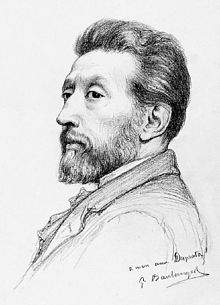Jules Duprato
Jules Duprato | |
|---|---|
 Jules Duprato. Portrait by Gustave Boulanger | |
| Born | 20 August 1827 |
| Died | 20 May 1892 (aged 64) |
| Occupation | Composer |
Jules Laurent Anacharsis Duprato (20 August 1827 – 20 May 1892)[1] was a 19th-century French composer.[2][3]
Biography
A student of Aimé Leborne[4] at the Conservatoire de Paris, he won first grand prix de Rome for musical composition in 1848.[2][5]
After the success of his opéra comique Les Trovatelles, performed at Salle Favart in 1854 and his operetta M'sieu Landry, premiered at Théâtre des Bouffes-Parisiens in 1856, expectations were high for the young composer.[6] His following works, however, including the operas La Déesse et le Berger (1863), La Fiancée de Corinthe (1867), and Le Cerisier (1874), rapidly fell into obscurity.[7]
He was appointed a professor of harmony at the conservatory in 1871.[8] He published several arrangements of La Marseillaise,[citation needed] wrote music for male chorus and one symphony.[9] His pupils included Robert Planquette,[2] Georges Douay,[2] and Antoine Simon.[10]

His grave at Montmartre Cemetery is decorated with a medallion by sculptor Gabriel Thomas.[11][12]
He was made chevalier of the Légion d'honneur in 1886.[5][8]
Notes
- ^ Birth certificate at the Chancellery of the Legion of Honour on base Léonore.
- ^ a b c d Wagstaff 1992.
- ^ Pougin 1878, p. 291; Remy 1919, p. 225.
- ^ For Aimé Leborne, see Q1028877 at Wikidata.
- ^ a b Pierre 1900, p. 775 "Hinard (Jules-Laurent-Anacharsis Duprato)".
- ^ Clauzel 1895, pp. 204–206.
- ^ Clauzel 1895, pp. 209–212, 216–217, 219–220, 236–237.
- ^ a b Pierre 1900, p. 442 "Duprato (Jules-Laurent-Anacharsis)".
- ^ Clauzel 1895, p. 236.
- ^ Remy 1919, p. 876.
- ^ Cimetières de France et d'ailleurs
- ^ Nouvelles archives de l'art français, tome XIII, p. 267-268, Charavay frères libraires de la Société de l'histoire de l'art français, Paris, 1897 (Read online)
Bibliography
- Clauzel, Paul (1895). "Jules Duprato, compositeur. Notice biographique", Mémoires de l'Académie de Nîmes, vol. 17, pp. 191–237. Nîmes: Clavel et Chastanier.
- Pierre, Constant, editor (1900). Le Conservatoire national de musique et de déclamation. Documents historiques et administratifs. Paris: Imprimerie National. Read online at Google Books.
- Pougin, Arthur (1878). "Duprato (Jules-Laurent-Anacharsis)", pp. 291–292, in Biographie universelle des musiciens et Bibliographie générale de la musique par F.-J. Fétis. Supplément et complément, vol. 1. Paris: Firmin-Didot. Read online at Google Books.
- Remy, Alfred (1919). Baker's Biographical Dictionary of Musicians. New York: G. Schirmer. Read online at Google Books.
- Wagstaff, John (1992). "Duprato, Jules Laurent (Anacharsis)", vol. 1, p. 1280, in The New Grove Dictionary of Opera, 4 volumes, edited by Stanley Sadie. London: Macmillan. ISBN 9781561592289. Also at Oxford Music Online (subscription required).
